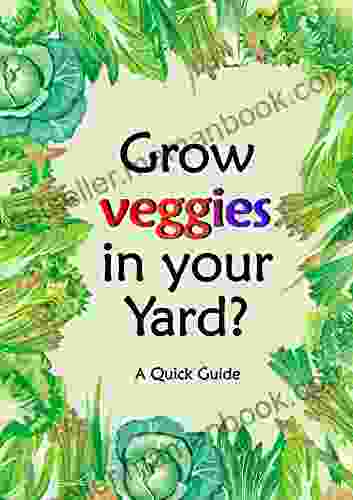Grow Veggies In Your Yard: A Comprehensive Guide to Growing Your Own Garden

Are you interested in growing your own vegetables? Growing veggies in your yard is a great way to get fresh, healthy produce, save money, and reduce your environmental impact. Plus, it's a fun and rewarding experience.
5 out of 5
| Language | : | English |
| File size | : | 1664 KB |
| Text-to-Speech | : | Enabled |
| Screen Reader | : | Supported |
| Enhanced typesetting | : | Enabled |
| Print length | : | 13 pages |
| Lending | : | Enabled |
This comprehensive guide will teach you everything you need to know to get started with growing veggies in your yard, from choosing the right plants to harvesting your crops. We'll also include tips on soil preparation, watering, and pest control.
Choosing the Right Plants
The first step to growing veggies in your yard is to choose the right plants. There are many different types of vegetables to choose from, so it's important to do your research and select ones that are well-suited to your climate and soil conditions.
Some of the most popular and easy-to-grow vegetables for beginners include:
- Tomatoes
- Cucumbers
- Zucchini
- Green beans
- Lettuce
- Radishes
- Carrots
Once you've chosen your plants, it's time to prepare the soil.
Soil Preparation
The soil in your yard is the foundation for a healthy garden. It provides nutrients and support for your plants, so it's important to prepare it properly before planting.
The first step is to test your soil. This will help you determine the pH level and nutrient content of your soil, which will help you make informed decisions about what to plant and how to fertilize.
Once you know the pH level and nutrient content of your soil, you can amend it to make it more suitable for growing vegetables. Some common soil amendments include:
- Compost: Compost is an organic material that adds nutrients and improves the structure of the soil.
- Manure: Manure is another organic material that adds nutrients to the soil.
- Lime: Lime is used to raise the pH level of the soil.
- Sulfur: Sulfur is used to lower the pH level of the soil.
Once you've amended the soil, it's time to plant your vegetables.
Planting
When planting your vegetables, it's important to space them properly. The spacing will vary depending on the type of vegetable you're planting. Be sure to read the seed packet or plant tag for specific instructions.
When planting, dig a hole that is twice as wide as the root ball of the plant. Place the plant in the hole and backfill with soil, tamping down gently to remove any air pockets.
Water the plants deeply after planting.
Watering
Water is essential for plant growth, but it's important to water your plants correctly. Overwatering can lead to root rot and other problems, while underwatering can stunt growth and make your plants more susceptible to pests and diseases.
The best way to water your plants is to use a soaker hose or drip irrigation system. These methods deliver water directly to the roots of the plants, without wetting the leaves. This helps to prevent disease and keeps the weeds down.
The amount of water you need to give your plants will vary depending on the type of vegetable, the weather conditions, and the soil type. A good rule of thumb is to water your plants deeply once a week, or more often if the weather is hot and dry.
Fertilizing
Fertilizing your plants helps to provide them with the nutrients they need to grow healthy and strong. There are many different types of fertilizers available, so it's important to choose one that is appropriate for the type of vegetables you're growing.
You can use a balanced fertilizer, which contains equal amounts of nitrogen, phosphorus, and potassium. Or, you can use a fertilizer that is specifically formulated for vegetables. Be sure to follow the instructions on the fertilizer label.
Pest Control
Pests can be a major problem in the garden. They can damage your plants and reduce your yields. There are many different types of pests, so it's important to identify the pests that are affecting your plants and then choose the appropriate control method.
Some common pest control methods include:
- Handpicking: This is the most effective way to control pests, but it can be time-consuming.
- Insecticides: Insecticides can be used to kill pests, but they should be used with caution. Be sure to read the label carefully and follow the instructions.
- Natural pest repellents: There are many natural pest repellents available, such as garlic spray and neem oil. These repellents can help to keep pests away from your plants.
Harvesting
Harvesting your vegetables is the final step in the growing process. It's important to harvest your vegetables at the right time, or they will lose their flavor and nutritional value.
The best time to harvest your vegetables will vary depending on the type of vegetable. However, there are some general guidelines you can follow:
- Tomatoes: Tomatoes are ripe when they are red and slightly soft to the touch.
- Cucumbers: Cucumbers are ripe when they are dark green and have a firm feel.
- Zucchini: Zucchini are ripe when they are dark green and about 6 inches long.
- Green beans: Green beans are ripe when they are bright green and snap easily.
- Lettuce: Lettuce is ripe when the leaves are green and tender.
- Radishes: Radishes are ripe when they are bright red and about 1 inch in diameter.
- Carrots: Carrots are ripe when they are bright orange and about 1 inch in diameter.
Once you've harvested your vegetables, enjoy the fruits of your labor!
Growing veggies in your yard is a rewarding experience. It's a great way to get fresh, healthy produce, save money, and reduce your environmental impact. Plus, it's a fun and educational activity that the whole family can enjoy.
If you're new to gardening, don't be afraid to ask for help from friends, family, or local gardening experts. There are also many resources available online and at your local library.
With a little planning and effort, you can grow a beautiful and bountiful vegetable garden in your yard.
5 out of 5
| Language | : | English |
| File size | : | 1664 KB |
| Text-to-Speech | : | Enabled |
| Screen Reader | : | Supported |
| Enhanced typesetting | : | Enabled |
| Print length | : | 13 pages |
| Lending | : | Enabled |
Do you want to contribute by writing guest posts on this blog?
Please contact us and send us a resume of previous articles that you have written.
 Top Book
Top Book Novel
Novel Fiction
Fiction Nonfiction
Nonfiction Literature
Literature Paperback
Paperback Hardcover
Hardcover E-book
E-book Audiobook
Audiobook Bestseller
Bestseller Classic
Classic Mystery
Mystery Thriller
Thriller Romance
Romance Fantasy
Fantasy Science Fiction
Science Fiction Biography
Biography Memoir
Memoir Autobiography
Autobiography Poetry
Poetry Drama
Drama Historical Fiction
Historical Fiction Self-help
Self-help Young Adult
Young Adult Childrens Books
Childrens Books Graphic Novel
Graphic Novel Anthology
Anthology Series
Series Encyclopedia
Encyclopedia Reference
Reference Guidebook
Guidebook Textbook
Textbook Workbook
Workbook Journal
Journal Diary
Diary Manuscript
Manuscript Folio
Folio Pulp Fiction
Pulp Fiction Short Stories
Short Stories Fairy Tales
Fairy Tales Fables
Fables Mythology
Mythology Philosophy
Philosophy Religion
Religion Spirituality
Spirituality Essays
Essays Critique
Critique Commentary
Commentary Glossary
Glossary Bibliography
Bibliography Index
Index Table of Contents
Table of Contents Preface
Preface Introduction
Introduction Foreword
Foreword Afterword
Afterword Appendices
Appendices Annotations
Annotations Footnotes
Footnotes Epilogue
Epilogue Prologue
Prologue Stanley Tucci
Stanley Tucci Marv Wolfman
Marv Wolfman Padmanabha Vd
Padmanabha Vd Ho Fung Hung
Ho Fung Hung Jacqueline Winters
Jacqueline Winters Edward Lee
Edward Lee Jim White
Jim White Michael Brandman
Michael Brandman Pietro Metastasio
Pietro Metastasio Jeffrey L Buller
Jeffrey L Buller Jj Perez
Jj Perez Jm Alvey
Jm Alvey Joshua Erik Rossi
Joshua Erik Rossi Sunday Cummins
Sunday Cummins John David Jackson
John David Jackson K M Robinson
K M Robinson Carmella Van Vleet
Carmella Van Vleet Joseph Heller
Joseph Heller Frank Wynne
Frank Wynne Haruichi Furudate
Haruichi Furudate
Light bulbAdvertise smarter! Our strategic ad space ensures maximum exposure. Reserve your spot today!

 Colin FosterUnveiling the Enchanting Tales from the Foxes of Foxham: A Literary Journey...
Colin FosterUnveiling the Enchanting Tales from the Foxes of Foxham: A Literary Journey...
 Norman ButlerIf Not For Him Then For Whom: A Profound Examination of Faith and Resilience
Norman ButlerIf Not For Him Then For Whom: A Profound Examination of Faith and Resilience Dean CoxFollow ·15.6k
Dean CoxFollow ·15.6k Eliot FosterFollow ·16.8k
Eliot FosterFollow ·16.8k Jackson HayesFollow ·14.5k
Jackson HayesFollow ·14.5k Dave SimmonsFollow ·3.5k
Dave SimmonsFollow ·3.5k Emilio CoxFollow ·17.6k
Emilio CoxFollow ·17.6k Ira CoxFollow ·13.7k
Ira CoxFollow ·13.7k Dashawn HayesFollow ·16.9k
Dashawn HayesFollow ·16.9k Aldous HuxleyFollow ·17.1k
Aldous HuxleyFollow ·17.1k

 David Foster Wallace
David Foster WallaceA Comprehensive Journey Through Economic Thought: A Brief...
Economics, the study of...

 Phil Foster
Phil FosterRecipes for Two: Nourish Your Body, Nourish Your...
Cooking and sharing meals together is one of...

 Alexandre Dumas
Alexandre DumasThe Ultimate Monkey Hat: Emery Leeann
If you're an animal lover,...

 Chadwick Powell
Chadwick PowellThe Breakbeat Poets Vol. 4: Black Girl Magic - Unveiling...
In the realm of...

 Dan Brown
Dan BrownAn Emotional and Touching Love Story: A Journey of Love,...
This is a love story that will stay with you...
5 out of 5
| Language | : | English |
| File size | : | 1664 KB |
| Text-to-Speech | : | Enabled |
| Screen Reader | : | Supported |
| Enhanced typesetting | : | Enabled |
| Print length | : | 13 pages |
| Lending | : | Enabled |










